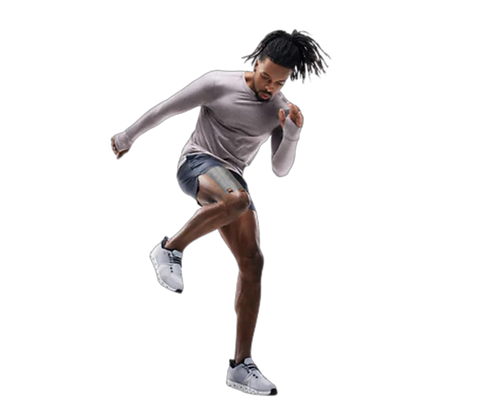
What Is Kinesiology Taping?
Kinesiology Taping (K-Taping) is a rehabilitative taping technique applied over muscles to reduce pain and inflammation, relax overused tired muscles and support muscles in movement.
How Does It Work?
4 FUNCTIONS OF K-TAPING
Mechanoreceptor Stimulation
The tape produces lift and stretch on the skin, which may stimulate mechanoreceptors. This interaction with the central nervous system can modulate pain.
Muscle Facilitation
& Inhibition
Kinesiology taping can alter muscle activity, with effects depending on the direction of application. It is used to either facilitate muscle function or inhibit overactive muscles.
Support &
Stability
The tape helps stabilize joints and support muscles without impeding movement, and it can prevent improper muscle contractions.
Improved Circulation
By lifting the skin, kinesiology tape is believed to enhance circulation and lymphatic flow, thus promoting the healing of injured tissues.

Potential skin lifting effect of Kinesiology Tape promoting fluid flow and decreasing tissue compression.

Benefits of Kinesiology Taping
Provide Support to a Muscle or Joint:
K-tape can be applied in a way that supports muscles and joints without restricting their natural range of motion. By providing a gentle pulling force on the skin and underlying tissues, K-Tape can help relax overly tense muscles and stimulate underactive ones, restoring more balanced muscle activity. This helps provide stability and can prevent further injury.
This support can also help improve alignment, which can be particularly helpful in conditions where muscle weakness or stiffness may lead to poor joint positioning.
Proprioception:
K-taping provides sensory feedback to the skin and underlying tissues through the increased stimulation to cutaneous mechanoreceptors. This can help individuals become more aware of their movements, which can improve proprioception. This can be particularly useful in neurological conditions, where proprioception may be impaired.
Improving Joint Proprioception:
After an injury or surgery, especially orthopedic procedures, joint awareness and stability may be compromised. K-taping can provide proprioceptive feedback to the joint, helping to improve stability and coordination to joints without limiting their range of motion. This support can help enhance the body's natural healing process, provide stability and help prevent further injury.
Supporting Rehabilitation Exercises:
During the recovery phase, patients often engage in physical therapy and exercises to restore strength, mobility, and function. K-tape can be used to support these exercises by promoting proper movement patterns and providing additional support while still allowing full range of motion.
Fascial Stretching:
K-tape can be applied to stretched skin to create a pulling force that acts on the fascia beneath. When returned to its resting state, the tape attempts to return to its original length, creating a biomechanical lifting effect that stretches the fascia. This creates more space for movement, separates adhesions, and improves the sliding and gliding environment, which can reduce tissue tension and improve movement patterns.
Benefits of Kinesiology Taping
Pain Relief:
When applied over painful areas, K-tape lifts the skin and creates more space in the underlying tissues. This can help reduce pressure on pain receptors, leading to a decrease in pain signals sent to the brain. Additionally, the gentle, continuous stimulation of the skin provided by the tape can help activate A-beta nerve fibers which work as an inhibitor of pain signals leading to a reduction in perceived pain.
Reduce Swelling and Bruising:
K tape can create more space beneath the skin which encourages improved circulation and lymphatic drainage. This helps to deliver nutrients to the area while also removing cellular waste and excess fluid from the interstitial tissues, helping to reduce swelling and bruising while speeding up the healing process.
Lymphatic Drainage:
K-taping can be used to help guide fluid away from congested areas, such as a surgical scar, towards areas with more functional lymphatic drainage. This can help to reduce swelling and promote healing.
Increasing Circulation:
he lifting action of K-tape on the skin can potentially increase blood flow to the area, which can aid in the healing process and help to reduce scar tissue formation.
Improving Muscle Function:
K-taping can help to facilitate muscle activation or inhibit overactive muscles, helping to restore balance and normal movement patterns in the neuromuscular system.


Practical Applications Of Kinesiology Taping
Musculoskeletal Injuries: K-Taping is commonly used to manage pain and support healing in conditions like sprained ankles, pulled muscles, and back pain.
Performance Enhancement: Athletes often use K-Tape to improve muscle function and movement efficiency, which can enhance performance.
Postural Correction: K-Taping can help retrain muscles to maintain better posture, which can alleviate strain and discomfort.
Lymphatic Drainage: Specific K-Taping techniques can help reduce swelling and improve lymphatic drainage in cases of edema or after surgery.
Rehab Post Surgery: Can help reduce swelling, improve blood flow to speed healing, and minimize the risk of compensatory imbalances or injuries.
Pregnancy Support: K-Taping can be used to provide support and relief for common discomforts during pregnancy, such as lower back pain or pelvic pain.
Neurological Conditions: K-Taping can help improve sensory feedback and muscle function in conditions like stroke or cerebral palsy.
Management of Scars: The gentle lift provided by the tape increases space under the skin to help reduce scar tissue and restrictions.
Pediatric Applications: For children with muscular imbalances or motor development issues, K-Taping can help improve muscle function and coordination.
Anti-Aging Applications: K-Taping can stimulate blood flow and circulation, which can improve skin elasticity and firmness over time. In addition, it promotes lymphatic drainage. Users applying it on the face might do so with the expectation that it can reduce puffiness, especially around the eyes and jawline.












